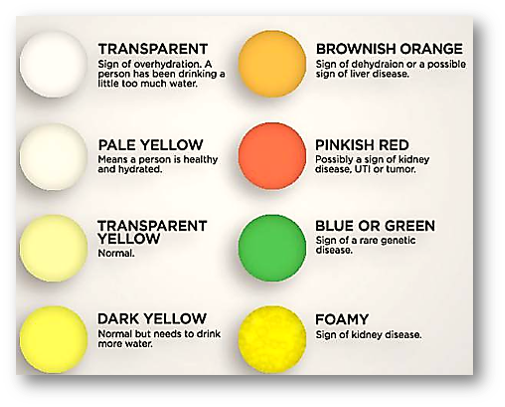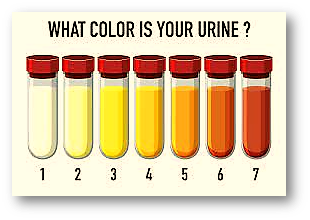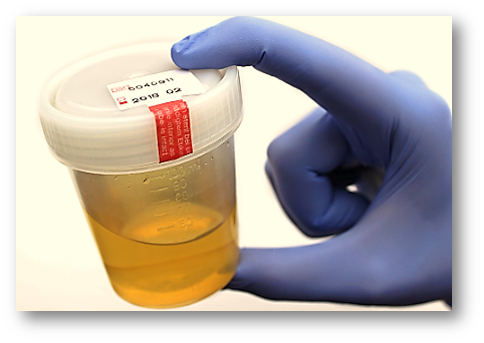The color, odor, and appearance of urine can vary depending on a number of factors, including hydration level, diet, and medication use. For example, well-hydrated individuals usually have pale yellow urine, while dark yellow or amber urine can indicate dehydration. As changes in urine color can indicate a variety of medical conditions.
It is important to note that urine color can also be affected by a variety of other factors, including diet, medication use, and supplements. Therefore, it’s not always a reliable indicator of a medical condition. However, if you notice any persistent changes in the color of your urine or other symptoms such as abdominal pain, fever, jaundice, lower back pain, muscle pain, or difficulty urinating, it’s important to seek medical attention.
URINE COLOUR & HEALTH CONCERNS!!

Noting the color of your urine can be an important indicator of your overall health, as changes in urine color can indicate a variety of medical conditions. For example, dark yellow or amber urine can indicate dehydration, while red or pink urine can indicate the presence of blood in the urine, which can be a sign of a urinary tract infection, kidney stones, or a more serious condition such as bladder or kidney cancer. Brown or tea-colored urine can indicate liver disease or the presence of bilirubin in the urine, which can be a sign of a number of conditions, including liver disease, hemolytic anemia, and Gilbert’s syndrome.
However, it is important to note that urine color can also be affected by a variety of other factors, including diet, medication use, and supplements. Therefore, it’s not always a reliable indicator of a medical condition.
That said, if you notice any persistent changes in the color of your urine or other symptoms such as abdominal pain, fever, jaundice, lower back pain, muscle pain, or difficulty urinating, it’s important to seek medical attention. A healthcare professional will be able to perform a physical examination, take a medical history, and order any necessary tests to help determine the cause of the change in urine color and provide appropriate treatment.
It’s also important to remember that urine color can change from day to day depending on the individual’s diet and hydration level, so it’s important to note any persistent change in urine color rather than considering a single instance.
WHEN SHOULD YOU GO FOR A URINE TEST OR A URINE DR??
Urine tests, also known as urinalysis, are commonly used to check for a variety of medical conditions. Here are some examples of when you may be asked to provide a urine sample for a test:
Regular check-ups:
Urine tests are often performed as part of a routine physical examination to check for early signs of disease.
Symptoms of a urinary tract infection:
If you have symptoms such as a frequent urge to urinate, a burning sensation when you urinate, or cloudy or strong-smelling urine, your healthcare provider may ask you to provide a urine sample to test for a urinary tract infection.
Symptoms of a kidney problem:
If you have symptoms such as blood in your urine, severe lower back pain, or difficulty urinating, your healthcare provider may ask you to provide a urine sample to test for a kidney problem.
Symptoms of a liver problem:
If you have symptoms such as yellowing of your skin or eyes (jaundice), abdominal pain, or dark-colored urine, your healthcare provider may ask you to provide a urine sample to test for a liver problem.
Symptoms of a metabolic disorder:
If you have symptoms such as excessive thirst or urination, weight loss, or fatigue, your healthcare provider may ask you to provide a urine sample to test for a metabolic disorder such as diabetes.
Monitoring of certain medical conditions:
If you have a medical condition such as diabetes or kidney disease, your healthcare provider may ask you to provide a urine sample on a regular basis to monitor your condition.
It’s always important to consult with your healthcare provider if you have any concerns or doubts about your health. They will be able to advise you on whether a urine test is necessary and when you should schedule one.
URINE COLOUR VARIATIONS!!

Urine color can vary depending on a number of factors, including hydration level, diet, and medication use. However, certain urine colors can be indicative of certain health conditions. For example:
- Dark yellow or amber urine
- Bright yellow urine
- Orange urine
- Red or pink urine
- Brown or tea-colored urine
- Green or blue urine
“It’s important to note that changes in urine color can also be caused by food, vitamins, and supplements, and it is not always a sign of a disease. If you have concerns about the color of your urine, you should speak with your healthcare provider.”
DARK YELLOW OR AMBER URINE!!
Dark yellow or amber urine can be a sign of dehydration, which means that your body does not have enough fluids to function properly. This can happen if you don’t drink enough water or if you lose fluids through sweating, vomiting, or diarrhea. When you are dehydrated, your kidneys hold on to more water to help maintain your body’s fluid balance, which can make your urine more concentrated and darker in color.
Other possible causes of dark yellow or amber urine can include:
- Liver or kidney disease
- Certain medications, such as rifampin, sulfonamides, and some laxatives
- High doses of vitamin B supplements
- Dehydration due to high fever, heavy sweating, or severe diarrhea
It’s important to note that other symptoms of dehydration can include fatigue, dry mouth, and dizziness. If you think you may be dehydrated, it’s important to drink more water and other fluids and to seek medical attention if your symptoms persist or worsen.
BRIGHT YELLOW URINE!!
Bright yellow urine is typically a sign that you are well hydrated. When you drink enough water, your urine becomes less concentrated and lighter in color. This is because your kidneys are able to flush out excess water and other waste products from your body, resulting in clear, pale yellow urine.
Other possible causes of bright yellow urine can include:
- High intake of vitamin B supplements, particularly vitamin B2 (riboflavin)
- Certain medications, such as sulfonamides
- Genetic disorders, such as Gilbert’s syndrome
It’s important to note that urine color can vary depending on a person’s diet and medications, so it’s not always a reliable indicator of hydration. If you are concerned about your hydration status, it’s important to monitor your fluid intake and pay attention to other symptoms of dehydration, such as dry mouth, fatigue, and dizziness. If you have any concerns or doubts, it’s always best to consult with your healthcare provider.
ORANGE URINE!!
Orange urine can be caused by a variety of factors, including diet, medications, and certain medical conditions. Some common causes of orange urine include:
Dehydration:
When you are dehydrated, your urine becomes more concentrated and darker in color, including orange.
Carrots, blackberries, beets, rhubarb, and food dyes:
These can cause your urine to turn orange.
Medications:
Some medications, such as rifampin, sulfasalazine, and some laxatives, can also cause orange urine.
Liver disease:
Orange urine can also be a sign of liver disease, such as hepatitis or cirrhosis. In these cases, the urine may also have a strong odor and may be cloudy or bloody.
If you notice that your urine is orange and you haven’t consumed any of these foods or medications, or if you have other symptoms such as abdominal pain, fever, or jaundice, it is important to see a doctor to rule out any underlying medical conditions.
Keep in mind that sometimes, a change in urine color could be due to certain foods or medications you have consumed, and it is not always a sign of a disease. Therefore, if you have any doubts or concerns, it’s always best to consult with your healthcare provider.
RED OR PINK URINE!!
Red or pink urine can be caused by blood in the urine, which is known as hematuria. Hematuria can occur for a variety of reasons, some of which are serious and some of which are not. Some common causes of red or pink urine include:
Urinary tract infection:
Bacteria can infect the bladder, urethra, or kidney, causing inflammation and bleeding.
Kidney or bladder stones:
Small stones that form in the urinary tract can cause irritation and bleeding as they pass through the urinary tract.
Medications:
Some medications, such as blood thinners and certain antibiotics, can cause bleeding in the urinary tract.
Trauma:
Injury to the urinary tract, such as from a fall or car accident, can cause bleeding.
Cancer:
Bladder or kidney cancer can also cause blood in the urine, although this is less common.
If you notice that your urine is red or pink and you have no apparent reason (such as eating beetroot or taking medications), or if you have other symptoms such as abdominal pain, lower back pain, or difficulty urinating, it is important to see a doctor immediately.
It’s important to note that red or pink urine can also be caused by other factors, such as menstrual bleeding, and it is not always a sign of a serious problem. Therefore, if you have any doubts or concerns, it’s always best to consult with your healthcare provider.
BROWN OR TEA-COLORED URINE!!
Brown or tea-colored urine can be caused by a variety of factors, some of which are serious and some are not. Some common causes of brown or tea-colored urine include:
Liver disease:
Bilirubin is a substance that is produced by the liver and excreted in the bile. High levels of bilirubin in the blood can cause jaundice and can make the urine brown or tea-colored.
Hemolytic anemia:
This is a condition in which red blood cells are destroyed faster than they can be replaced, leading to the release of bilirubin and resulting in brown or tea-colored urine.
Rhabdomyolysis:
It is a condition in which muscle tissue breaks down, releasing a protein called myoglobin into the bloodstream. Myoglobin can damage the kidneys and cause brown or tea-colored urine.
Certain medications:
Some medications, such as methocarbamol, can turn urine brown.
It’s important to note that brown or tea-colored urine can also be caused by other factors, such as eating certain foods, such as fava beans, and it is not always a sign of a serious problem. Therefore, if you have any doubts or concerns, it’s always best to consult with your healthcare provider.
If you notice that your urine is brown or tea-colored, and you have no apparent reason, or if you have other symptoms such as abdominal pain, jaundice, or muscle pain, it is important to see a doctor immediately as it could be a sign of a serious condition.
GREEN OR BLUE URINE!!
Green or blue urine can be caused by a variety of factors, some of which are serious and some of which are not. Some common causes of green or blue urine include:
Medications:
Certain medications, such as the antibiotic methylene blue, can turn urine green or blue.
Food dyes:
Consuming large amounts of food dyes, such as those used in colored drinks, can also cause green or blue urine.
Genetic disorder:
Familial hypercalcemia is a rare genetic disorder that can cause blue or green urine. This disorder is caused by the overproduction of a hormone called parathyroid hormone, which can lead to high levels of calcium in the blood and urine.
It’s important to note that green or blue urine can also be caused by other factors, and it is not always a sign of a serious problem. Therefore, if you have any doubts or concerns, it’s always best to consult with your healthcare provider.
If you notice that your urine is green or blue and you have no apparent reason, or if you have other symptoms such as abdominal pain, muscle weakness, or bone pain, it is important to see a doctor immediately as it could be a sign of a serious condition.
KEYWORDS: Urinary tract infection (UTI), Kidney disease, Nephritis, Nephrotic syndrome, Kidney stones, Bladder cancer, Prostate cancer, Urinary incontinence, Interstitial cystitis, Hematuria (blood in urine), Proteinuria (protein in urine), Glomerulonephritis, Urethral stricture, Urethritis, Pyelonephritis, Cystitis, Urolithiasis, Hydronephrosis, Renal failure, Urinary tract obstruction, Ureteral obstruction, Ureteropelvic junction obstruction, Vesicoureteral reflux, Urinary tract calculi,
REFERENCES:
https://link.springer.com/article/10.1007/s00394-015-0905-2
https://journals.sagepub.com/doi/pdf/10.1177/1099800405281607


Pingback: PLATELET COUNTS ARE A CAUSE OF CONCERN!! - Life Biologs
Pingback: INSULIN HORMONE AND DIABETES!! - Life Biologs